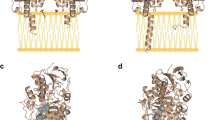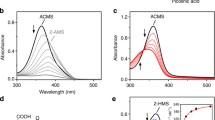Abstract
Reversible monoamine oxidase A inhibitors (RIMA) are used as antidepressants but little is known about how they interact with the active site of the enzyme. Heterologous expression of human liver MAO-A in yeast provides sufficient protein for molecular studies and direct observation of the changes in the spectrum of the FAD co-factor when inhibitors bind. Using the reversible inhibitor, D-amphetamine, as a model compound, a concentration-dependent change in the spectrum with clean isosbestic points was observed. The decrease in absorbance between 400 and 500 nm gave a dissociation constant for binding similar to the K i value. Anaerobic reduction yielded the semiquinone spectrum only and the midpoint potential was the same as the free enzyme. Full reduction was not possible with dithionite as the reductant, suggesting that the semiquinone-reduced couple had a much lower midpoint potential than the free enzyme. In contrast, with substrate, which reduces the enzyme on an equimolar basis, the semiquinone is never seen. In anaerobic stopped-flow experiments, amphetamine inhibits completely the reoxidation of the reduced enzyme in contrast to a substrate such as 2-phenylethylamine (the desmethyl analogue of amphetamine) that accelerates the rate 12-fold. The spectral changes in MAO-A permit the examination of inhibitor interaction with the redox co-factor. Stacking of the inhibitor and flavin rings constitutes part of the interaction but, taking into account other evidence, steric factors may be the clue to the differences between substrate and inhibitor.
Similar content being viewed by others
REFERENCES
Binda, C., Newton-Vinson, P., Hubalek, F., et al. (2002). Structure of human monoamine oxidase B, a drug target for the treatment of neurological disorders, Nature Struct. Biol. 9, 22–26.
Codoñer, A., Medina, P., Ortiz, C. and Jover, E. (1993). Spectroscopic study of molecular associations between riboflavin and some (dihydro) β-carboline derivatives, Spectrochim. Acta 49A, 321–327.
Kim, H., Sablin, S. O., Ramsay and R. R. (1997). Inhibition of monoamine oxidase A by β-carboline derivatives, Arch. Biochem. Biophys. 337, 137–142.
Miller, J. R. and Edmondson, D. E. (1999). Structure–activity relationships in the oxidation of para-substituted benzylamine analogs by recombinant human liver monoamine oxidase A, Biochemistry 38, 13670–13683.
Miller, J. R. and Edmondson, D. E. (2000). Evidence for altered binding modes in the interaction of bezylamine analogues with bovine liver monoamine oxidase B, Biochim. Biophys. Acta 1479, 52–58.
Moureau, F., Wouters, J., Depas, M. et al. (1995). A reversible monoamine oxidase inhibitor, toloxatone: comparison of tis physicochemical properties with those of other inhibitors including Brofarmine, Harmine, R40519 and Moclobemide, Eur. J. Med. Chem. 30, 823–838.
Niemz, A. and Rotello, V. M. (1999). From enzyme to molecular device. Exploring the interdepen-dence of redox recognition, Acc. Chem. Res. 32, 44–52.
Ramsay, R. R. (1991). The kinetic mechanism of monoamine oxidase A, Biochemistry 30, 4624–4629.
Ramsay, R. R., Sablin, S. O. and Singer, T. P. (1995). Redox properties of the flavin cofactor of monoamine oxidases A and B and their relationship to the kinetic mechanism, Progr. Brain Res. 106, 33–39.
Robinson, J. B. (1985). Stereoselectivity and isoenzyme selectivity of monoamine-oxidase inhibitors -- enantiomers of amphetamine, N-methylamphetamine and deprenyl, Biochem. Pharmacol. 34, 4105–4108.
Sablin, S. O. and Ramsay, R. R. (1998). Monoamine oxidase contains a redox-active disulfide, J. Biol. Chem. 275, 14074–14076.
Saura, J., Bleuel, Z., Ulrich, J. et al. (1996). Molecular neuroanatomy of human monoamine oxidases A and B revealed by quantitativeenzyme radioautographyand in situ hybridizationhistochemistry, Neuroscience 70, 755–774.
Silverman, R. B. (1995). Radical Ideas about monamine oxidase, Acc. Chem. Res. 28, 335–342.
Tan, A. J. and Ramsay, R. R. (1993). Substrate-specific enhancement of the oxidative half-reaction of monoamines oxidase, Biochemistry 32, 2137–2143.
Weyler, W. and Salach, J. I. (1985). Purification and properties of mitochondrial monamine oxidase type-A from human placenta, J. Biol. Chem. 260, 13199–13207.
Weyler, W., Titlow, C. C. and Salach, J. I. (1990). Catalytically active monamine oxidase type-A from human liver expressed in Saccharomyces cerrevisiae contains covalent FAD, Biochem. Biophys. Res. Commun. 173, 1205–1211.
Rights and permissions
About this article
Cite this article
Ramsay, R.R., Hunter, D.J.B. Interactions of D-amphetamine with the active site of monoamine oxidase-A. Inflammopharmacology 11, 127–133 (2003). https://doi.org/10.1163/156856003765764290
Issue Date:
DOI: https://doi.org/10.1163/156856003765764290




